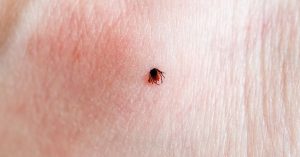
Overall, the number of individuals contracting Babesia is rising. The annual number of cases per year climbed from 4 per 100,000 to 9 per 100,000 in the U.S. between 2006 and 2017. The annual number of cases of Babesia per year for individuals over the age of 85 was 4 out of 100,000. In comparison, the number of Lyme disease cases among the elderly was 15.98 per 100,000. Geriatric Babesia cases are also rising and may require longer treatment
Most of the cases of Babesia occurred in the Lyme-endemic states of Massachusetts, Rhode Island, Connecticut, New York, and New Jersey, according to the authors. Other states recording Babesia cases included Florida, Pennsylvania, California, Maryland, and Virginia. Some cases of Babesia were also reported in New Hampshire, Maine, Vermont, Minnesota, Wisconsin, Texas, North Carolina, and Illinois.
The most common test used to diagnose Babesia was a blood smear in the institutional setting, wrote Menis in a related paper. [2] The intracellular parasite in the red blood cell clears after a few days. The most common tests used in a physician’s office involved antibody or PCR testing. [2]
Co-infections can be deadly
A Babesia infection can be serious for patients. “Patients co-infected with Lyme disease experienced more symptoms and a more persistent episode of illness than did those (n=10) experiencing babesial infection alone,” wrote Krause and colleagues [3]. In another paper, the authors explain, “Immunocompromised people who are infected by B. microti are at risk of persistent relapsing illness.” [4]
For some patients, including the elderly, Geriatric Babesia cases are rising and may require longer treatment infection can be more serious. “Babesiosis can be life threatening, particularly for persons who are asplenic, immunocompromised, or elderly,” wrote Krause et al. [4]
85-year-old dies from Babesia and Ehrlichia
Javed and colleagues describe the case of an 85-year-old man who died of a concurrent Babesiosis and Ehrlichiosis infection. [5]
He was an avid gardener and golfer in good health except for hypertension. He did not have a tick bite or rash. The man was hospitalized with weakness and jaundice. He had mild anemia, a very low platelet count, a mildly elevated bilirubin, and mildly reduced renal function.
The doctors diagnosed Babesia based on a bone marrow biopsy revealing intraerythrocytic inclusions (tetrads), typical of babesiosis. In retrospective, his admitting bloods from admission revealed parasitemia in 8% of the red blood cells. The Babesia antibody IgM and IgG were positive for Babesia.
READ MORE: Elderly Lyme disease patients more likely to have unfavorable treatment outcomes
The elderly man was treated with IV clindamycin and IV quinine. His anemia worsened despite transfusion of two units of blood and he was transferred to a tertiary hospital for possible exchange transfusion. The doctor added azithromycin but not Atovaquone.
His condition worsened. His oxygen saturation dropped to 84% and he subsequently developed bilateral pneumonia, renal failure, hepatic failure, and a coma. He was too ill to tolerate exchange transfusion.
He died within 60 hours of admission to the tertiary care center.
Post-mortem tests were positive for Human Monocytic Ehrlichiosis, the cause of Ehrlichia. He was never treated with doxycycline, the most commonly prescribed medication for Ehrlichia.
Treatment of Babesia
Krause and colleagues reported that a 10-day course of Mepron and Zithromax would be as effective as clindamycin and quinine and have less side effects. [3] The Medicare beneficiaries were far more likely to be prescribed Mepron with Zithromax than clindamycin and quinine. [1]
Some patients with Geriatric Babesia require longer treatment. Krause and colleagues reported immunocompromised and elderly patients were more likely to need longer term therapy.” [4]
“Cases of Babesia among the elderly are rising and studies report patients more likely to require longer treatment.”
In another paper, the authors point out that, “Such patients generally require antibabesial treatment for >or=6 weeks to achieve cure, including 2 weeks after parasites are no longer detected on blood smear.” [4]
More than one-third of Geriatric Babesia patients were not treated with anti-Babesia treatment during their evaluation. The study was not designed to determine if the elderly were subsequently treated.
IDSA position
The 2020 Infectious Diseases Society of America (IDSA) guidelines for Babesia highlighted concerns regarding severe Babesia in the elderly. “Numerous immunodeficiencies and comorbidities have been associated with severe babesiosis, including asplenia and hyposplenism, cancer, congestive heart failure, HIV infection, immunosuppressive drugs, and advanced age.” [6]
For immunocompromised patients, we suggest monitoring Babesia parasitemia using peripheral blood smears even after they become asymptomatic and until blood smears are negative. PCR testing should be considered if blood smears have become negative but symptoms persist (weak recommendation, moderate-quality evidence).
In addition, the IDSA guidelines advised longer treatment for immunocompromised Babesia patients. “A subgroup of highly immunocompromised patients reported in a case control study required at least 6 consecutive weeks of antibiotic therapy, including 2 final weeks during which parasites were no longer detected on peripheral blood smear.” [6]
However, some patients can relapse. “A few cases of relapse despite at least 6 consecutive weeks of atovaquone plus azithromycin demonstrate that resistance to atovaquone and/or azithromycin can emerge in highly immunocompromised patients during an extended course of this antibiotic combination,” wrote Krause et al. [6]
Editor’s note: I share the same concerns regarding Geriatric Babesia, and I base the length of antibiotics on the patient’s response to treatment.
Related Articles:
Tick bite causes 3 diseases in elderly woman
Lyme disease mimics autoimmune disorder in elderly woman
Podcast: Confusion in elderly woman with anaplasmosis and babesia infection
References:
- Menis M, Whitaker BI, Wernecke M, et al. Babesiosis Occurrence among the U.S. Medicare Beneficiaries Ages 65 and Older, During 2006-2017: Overall, and by State and County of Residence. Open Forum Infectious Diseases. 2020
- Menis M, Forshee RA, Kumar S, McKean S, Warnock R, Izurieta HS, Gondalia R, Johnson C, Mintz PD, Walderhaug MO, Worrall CM, Kelman JA, Anderson SA. Babesiosis Occurrence among the Elderly in the United States, as Recorded in Large Medicare Databases during 2006-2013. PLoS One. 2015 Oct 15;10(10)
- Krause PJ, Telford SR, 3rd, Spielman A, et al. Concurrent Lyme disease and babesiosis. Evidence for increased severity and duration of illness. JAMA. Jun 5 1996;275(21):1657-60.
- Krause PJ, Gewurz BE, Hill D, et al. Persistent and relapsing babesiosis in immunocompromised patients. Clin Infect Dis. Feb 1 2008;46(3):370-6. doi:10.1086/525852
- Javed MZ, Srivastava M, Zhang S, Kandathil M. Concurrent babesiosis and ehrlichiosis in an elderly host. Mayo Clin Proc. May 2001;76(5):563-5. doi:10.4065/76.5.563
- Krause PJ, Auwaerter PG, Bannuru RR, et al. Clinical Practice Guidelines by the Infectious Diseases Society of America (IDSA): 2020 Guideline on Diagnosis and Management of Babesiosis. Clin Infect Dis. Nov 30 2020;doi:10.1093/cid/ciaa1216



12/20/2023
Dr Cameron ,
First thank you for all you do for patients.
I’m 60 yr, female, diagnosed with Lyme and co-infection Babiosis in summer of 2007. I lived in MN at time of diagnosis. 2 yrs prior I was diagnosed as having Fibromyalgia. 2006 jaw pain was bad dental work didn’t decrease pain so I allowed Drs to pull all my upper and lower teeth. The pain has only increased over the years. Ill fitting dentures, 7 sets since 2006. Added lower implant/bone (2)early 2023. My bones are disappearing.
When diagnosed in 2007 I was given Doxycycline. 2 months. I was still sick and getting sicker but was told the antibiotics took care of the Lyme and Babesia. Since I’ve been on so many different medications for suicidal ideation, I rejected many over the years. They just didn’t work in my system. Now on Concerta 54 ER, 2-20 mg Ritalin IR, Duloxetine 120mg, Diazepam 5mg for my severe anxiety. These from psychiatrist. Then there is Losartan 50-100mg for Blood Pressure, Furisimide 20mg for swelling in lower legs.
Ipatropium .06% nasal spray for the clear liquid that runs out my nose, Flonase for allergies environmental. Oxycodone HCI 15 mg IR 1 every 6 hours for the constant diffuse pain I’ve had since 2005. My medical issues are abhorrent. I have so many on my list and more that aren’t even listed. These are issues that were recognized by Radiologists from CT scans and MRI’s. Brain has a pituitary cyst, pineal gland has been seen as calcified, one report said I have scattered perivascular CFS spaces throughout the basal ganglia , faint medical left parietal lobe which may reflect a incidental developmental venous anomaly. Cystic structure within pituitary gland 7.0×9.7×7.2 cm. This was October 25 2014. November 2015 size 7.0×6.3mm
I had surgery 2021 cleanup and fused L-4L-5, in the notes of the Radiologist was seen ovarian cyst 2.4 cm. Spoke to Dr about that he said every one has them. Now that cyst is 4.0 cm. Will watch it. I have facial numbness both sides all the time for over a year now. It started as a small patch under left eye approximately 3 years ago. I’ve had 3 sprains this year knees and ankle, steroid injections shoulders, hip, back and neck. Nerve burns in neck and low back several times also.
Arthritis of some kind that at present is really flared in about all my knuckles both hands and feet. I bend over and sweat pores our my head around the temple area. Night sweats always. I get fevers that cause my skin on lips to dry and peel off sometimes several times a day. Consentration leaves me stranded and wondering what I was doing or where I’m going. Can’t remember so I see something else that needs taken care of on I go. I’ve forgotten most of my children’s young lives. I’ve forgotten all I learned as a massage therapist bones, muscle, nerves ect. My oxygen level is running around 91-98. My skin is mottled most of my body. There is so much more thyroid, kidney, urine output etc I don’t know why Drs
Won’t treat me. I’ve gave them books and many of the articles you have written. To no avail.
Merry Christmas Dr Cameron
March 2017 size of Pituitary cyst 6x4x6mm